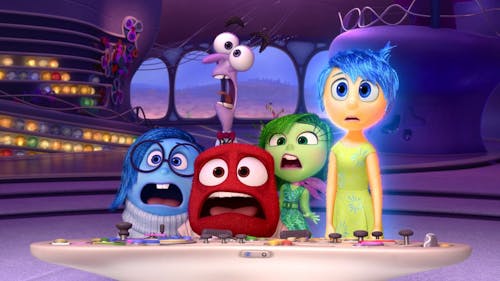How movies externalize emotions to enamour audiences

The year is 2000, and if you’re a kid during this time, that means one thing: You’re probably snacking on Scooby-Doo gummies and watching the newest hit movie, “The Emperor's New Groove.”
But as we mindlessly munched on snacks and laughed at this emperor-turned-llama, we didn't realize we were being accustomed to a movie technique we see in some of the best flicks — the externalizing of emotions.
In “The Emperor's New Groove,” the emperor went through a personal transformation, but not in the way people typically do. Mark Dindal, director of the film, chose to show Emperor Kuzco’s evolution and karmic predicament by introducing a physical, unavoidable quandary for the Emperor: turning him into a llama.
“The Emperor's New Groove” is a perfect example of how films give a physical form to a character's emotions and experiences. Movies and television both do this regularly, often conveying emotions like melancholy, fear and joy through tangible elements, i.e, secondary characters or mythological phenomena.
There is an array of present-day examples we can look at. Take for example the children's movie, “Inside Out” (2015) or the new Netflix series, “Living with Yourself” (2019).
“Inside Out” is one of the greatest and most creative examples of this practice in which Pete Docter, the director, created a world where every person had five people in their heads who sat in a control panel and had control of one’s emotions. The characters inside of one’s brain are named after their respective emotions: disgust, fear, sadness, joy and anger.
The emotions had personalities of their own, collaborating with each other to solve problems and vying for jurisdiction over how to approach a situation. In fact, it was these characters that made the movie what it was.
On the surface level, “Inside Out” is about a young girl who begins to act out and finds herself often feeling angry and sad as she and her parents move to San Francisco. Docter could have chosen to tell the story in that manner, but we have all seen at least five movies about kids transitioning after moving.
The technique of externalizing emotions is used often due to its power. It adds allure to stories just as much as it makes us feel the emotions of the characters even stronger, in a way acting on its own can’t.
Docter did just that, not only giving us a storyline to follow, but also helping us gain a new perspective on the issue at hand, in a fun and insightful way.
Similarly, the new series, “Living with Yourself,” chronicles a man (Paul Rudd) who goes to a special doctor who promises to make him the best version of himself. When he wakes up, he finds that he is still himself, but now, he has a clone that is a perfect version of himself running around the world.
In this series, the best and worst versions of the character come to life in a physical way as viewers get to see both versions of the same person literally separated.
Similarly, movies like the iconic Wes Anderson film, “The Royal Tenenbaums,” and the 2009 cult classic, “500 Days of Summer,” use this practice constantly with their use of color and unrealistic scenarios, i.e., coincidentally raining when a character is sad.
The greatest example in “500 Days of Summer” happens after the first sex scene. Tom is over the moon, beaming, as he walks down the street. Everyone and everything is beautiful, he greets everyone he passes and eventually everyone erupts into a flash mob to the song “You Make My Dreams.” But when Tom’s relationship doesn't work out, the world is grey, rainy and void of flash mobs.
I can go on, and you can too, thinking about all the movies and shows that depict very real emotions by introducing unrealistic elements to their stories. It’s a misconception to think that this technique shows a weakness on an actor's part, or that it is a lazy move on the director’s part.
No one needs to spell out to us that the externalization of emotions isn't realistic. We don’t have an angel and devil on our shoulders whenever we have a moral conflict, five little people in our heads controlling how we feel or a flash mob in the street every time we have sex.
But we can all agree that if movies were 100% identical to real life, we wouldn't watch them.
You need to add an element on the screen that conveys an emotion to the audience in a bold and overemphasized manner, and oftentimes, that is best achieved by emotions taking on a physical form of their own.



